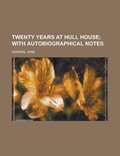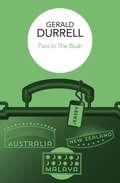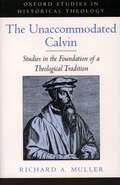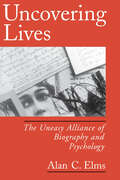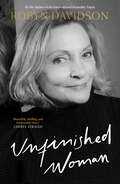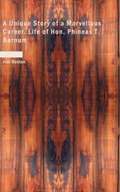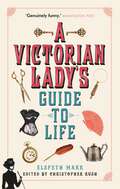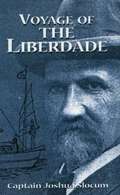- Table View
- List View
Twenty Years at Hull House; with Autobiographical Notes
by Jane AddamsWhile on a trip to East London in 1883, Jane Addams witnessed a distressing scene late one night: masses of poor people were bidding on rotten vegetables that were unsalable anywhere else. <P> <P> Their pale faces were dominated by that most unlovely of human expressions, the cunning and shrewdness of the bargain-hunter who starves if he cannot make a successful trade, and yet the final impression was not of ragged, tawdry clothing nor of pinched and sallow faces, but of myriads of hands, empty, pathetic, nerveless, and workworn, showing white in the uncertain light of the street, and clutching forward for food which was already unfit to eat. <P> <P> This scene haunted Addams for the next two years as she traveled through Europe, and she hoped to find a way to ease such suffering. Five years later, she visited Toynbee Hall, a London settlement house, and resolved to replicate the experiment in the U.S. On September 18, 1889, Jane Addams and her friend Ellen Starr moved into the second floor of a rundown mansion in Chicago's West Side. From the outset, they imagined Hull-House as a "center for a higher civic and social life" in the industrial districts of the city. Addams, Starr, and several like-minded individuals lived and worked among the poor, establishing (among other things) art classes, discussion groups, cooperatives, a kindergarten, a coffee house, a lending library, and a gymnasium. In a time when many well-to-do Americans were beginning to feel threatened by immigrants, Hull-House embraced them, showed them the true meaning of democracy, and served as a center for philanthropic efforts throughout Chicago. <P> <P> Hull-House also provided an outlet for the energies of the first generation of female college graduates, who were educated for work yet prevented from doing it. In some respects, however, Addams's impressive work, often hailed by historians as "revolutionary," was nothing of the sort. She embraced the sexual stereotypes of her day, and, though she was clearly an independent woman, soothed public fears by acting primarily in the traditional roles of nurturer and caregiver. Hull-House was a rousing success, and it inspired others to follow in Addams's footsteps. Though Twenty Years at Hull-House is meant to be an autobiography, it is Hull-House itself that stands in the spotlight. Addams devotes the first third of the book to her upbringing and influences, but the remainder focuses on the organization she built--and the benefits accruing to those who work with the poor as well as to the poor themselves. At times Addams's prose is difficult to follow, but her ideals and her actions are truly inspiring. A classic work of history--and a model for today's would-be philanthropists. --Sunny Delaney
Two Expeditions into the Interior of Southern Australia
by Charles SturtTwo expeditions into the interior of Southern Australia during the years 1828-1831, with observations on the soil, climate and resources of New South Wales.
Two in the Bush (El\libro De Bolsillo Ser.)
by Gerald DurrellTwo in the Bush is a record of the six-month journey which took Gerald Durrell, his wife Jacquie, and two cameramen through New Zealand, Australia and Malaya. The object was, first, to see what was being done about the conservation of wild life in these countries, and, secondly, to make a series of television films for the BBC. They were introduced to many rare and remarkable animals – Royal Albatrosses, Tuataras, Duck-Billed Platypuses, Flying Lizards and Long-Nosed Bandicoots, as well as to some equally unusual humans. Anyone who has read The Overloaded Ark, The Bafut Beagles or The Whispering Land will have enjoyed Gerald Durrell’s enthusiastic adventuring and his delight in the absurdity of the situations in which he finds himself. His observation of animal – and human – behaviour is always informative and often hilarious. ‘Delightfully readable and often very funny.’ Daily Mail ‘An account of Gerald Durrell’s tour of New Zealand, Australia and Malaya in search of rarities . . . Easy to read, difficult to put down, with many vivid sidelights on the human side of the expedition. This absorbing narrative reveals the ardours, ironies and disappointments, the organizational miracles and the hilarious human mishaps . . .’ Maurice Wiggin, Sunday Times ‘Mr Durrell has the knack of writing about animals and their antics with tremendous affection and enthusiasm, but without sentimentality.’ Sunday Telegraph ‘Will delight his fans and armchair naturalists everywhere.’ Evening Standard
The Unaccommodated Calvin: Studies In The Foundation Of A Theological Tradition
by Richard A. MullerUnfinished Woman
by Robyn Davidson'The zigzagging life of an adventurer' GUARDIAN'An astonishing, wonderful memoir of an extraordinary life' HENRY MARSH, author of Do No Harm'Exciting and complex, full of insight and humour' SPECTATORAn unforgettable memoir from the author of the sensational international bestseller Tracks: the story of a mother and daughter, of love, loss and the pursuit of freedomIn 1977, twenty-seven-year-old Robyn Davidson set off with a dog and four camels to cross 1,700 miles of Australian desert to the sea. A life of almost constant travelling followed. From the deserts of Australia, to Sydney's underworld; from Sixties street life, to the London literary scene; from migrating with nomads in Tibet, to 'marrying' an Indian prince, Davidson's quest was motivated by an unquenchable curiosity about other ways of seeing and understanding the world. Davidson threw bombs over her shoulder and seeds into her future on the assumption that something would be growing when she got there. The only terrain she had no interest in exploring was the past. In Unfinished Woman Davidson turns at last to explore that long avoided country. Through this brave and revealing memoir, she delves into her childhood and youth to uncover the forces that set her on her path, and confront the cataclysm of her early loss. Unfinished Woman is an unforgettable investigation of time and memory, and a powerful interrogation of how we can live with and find beauty in the uncertainty and strangeness of being.'In her twenties, Davidson trekked 1,700 miles through the Australian wilderness. This led to the bestselling book Tracks and global fame. Half a century later she has written about what motivated her – including the tragic early death of her mother' Simon Hattenstone, GUARDIAN
A Unique Story of a Marvellous Career: Life of Hon. Phineas T. Barnum
by Joel BentonThere is none that stands for more notable success in his chosen line none that recalls more memories of wholesome entertainment none that is more invested with the fragrance of kindliness and true humanity.
Up From Slavery: An Autobiography
by Booker T. WashingtonHailed one of best American autobiographies ever written, Booker T. Washington recounts his life.
Vanished Arizona, Recollections of the Army Life by a New England Woman
by Martha SummerhayesI have written this story of my army life at the urgent and ceaseless request of my children.
Venetain Years, Volume 1e: Milan and Mantua
by Jacques CasanovaVenetian Years, book 1e, "Milan and Mantua"
Venetian Years, Volume 1c: Military Career
by Jacques CasanovaThis book is the number 1c of "Venetian Years" by Jacques Casanova de Seingalt
A Victorian Lady's Guide to Life
by Elspeth MarrIn this delightful and engagingly eccentric treasury of life lessons, redoubtable Victorian Elspeth Marr (1871–1947) reflects on the fundamental topics of life as well as the nuts and bolts of everyday living. Part journal, part commonplace book, among many gems you will find enlightenment and advice on everything from Dreams to Garlic; Patriotism to Wrinkles.Written throughout her life but only discovered after her death, by her great-great nephew, Christopher Rush, Elspeth’s (known as Aunt Epp) journal was never intended for publication but her style of writing and the subject matter she covers nonetheless reaches a universal audience. Not afraid to put forth views on the big topics – religion, evolution, and ethical issues – she also tackles the nuts and bolts of living – food, sex and health.Vital, refreshingly frank and always amusing, A Victorian Lady’s Guide to Life provides a wealth of sound advice.
Vida de Lazarillo Tormes
by AnónimoA fictional story of a street boy's apprenticeship to a blind beggar, a miserly priest, a bankrupt gentleman. Lazarillo's tale is a wicked satire of venality, pretense, and brazen self-seeking.
Virginia Woolf and Heritage (Clemson University Press)
by Jane DeGay Tom Breckin Anne ReusThis volume aims to situate Virginia Woolf as a writer who, despite her fame as a leading modernist, also drew on a rich literary and cultural heritage. The chapters in this volume explore the role her family heritage, literary tradition and heritage locations play in Woolf’ s works, uncovering the influence the past had on her work, and particularly her deep indebtedness to the Victorian period in the process. It looks at how she reimagined heritage, including her queer readings of the past. This volume also aims to examine Woolf’ s own literary legacy: with essays examining her reception in Romania, Poland and France and her impact on contemporary writers like Alice Munro and Lidia Yuknavitch. Lastly, Woolf’ s standing in the increasingly popular field of biofiction is explored. The collection features an extended chapter on Virginia Woolf’ s relationship with her cousin H.A.L. Fisher by David Bradshaw, and an extended chapter by Laura Marcus on Woolf and the concept of shame.
Vivre Ici: Space, Place and Experience in Contemporary French Documentary (Contemporary French and Francophone Cultures #50)
by Alison J. Murray LevineVivre Ici invites the reader on a journey through the vast viewing landscape of contemporary French documentary film, a genre that has experienced a renaissance in the past twenty years. The films explored are connected not just by a general interest in engaging the “real,” but by a particular attention to French space and place. From farms and wild places to roads, schools, and urban edgelands, these films explore the spaces of the everyday and the human and non-human experiences that unfold within them. Through a critical approach that integrates phenomenology, film theory, eco-criticism and cultural history, Levine investigates the notion of documentary as experience. She asks how and why, in the contemporary media landscape, these films seek to avoid argumentation and instead, give the viewer a feeling of “being there.” As a diverse collection of filmmakers, both well-known and lesser-known, explore the limits and possibilities of these places, a collage-like, incomplete, and fragmented vision of France as seen and felt through documentary cameras comes into view. Venturing beyond film analysis to examine the production climate for these films and their circulation in contemporary France, Levine explores the social and political consequences of these “films that matter” for the viewers who come into contact with them.
Voyage of the Liberdade
by Joshua SlocumIn 1890, the author became the first person to circumnavigate the globe alone. This is the account of one of his lesser-known but no less remarkable sea journeys. From the Publisher: Great 19th-century mariner's thrilling, account of the wreck of his ship off the coast of South America, the 35-foot brave little craft he built from the wreckage, and its remarkable, danger-fraught voyage home. A 19th-century maritime classic brimming with courage, ingenuity, and daring. Easy-to-read and fast-paced.
